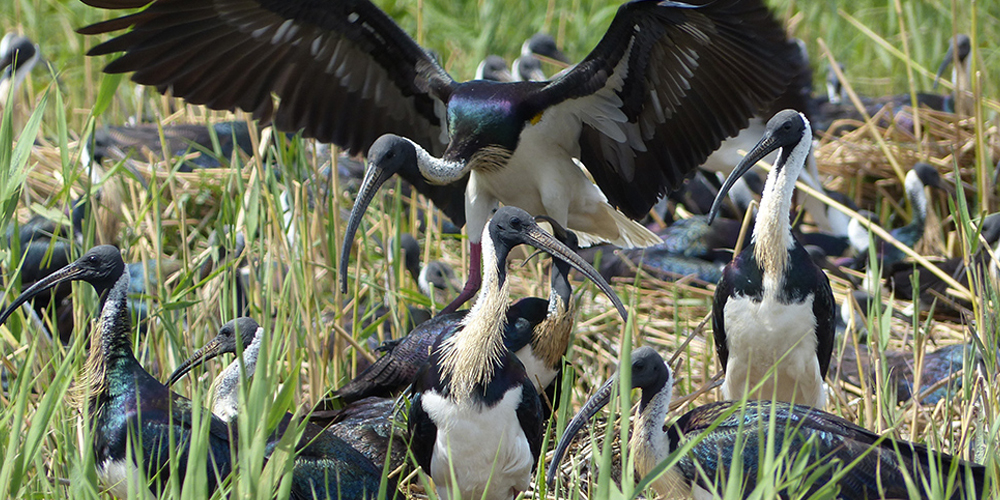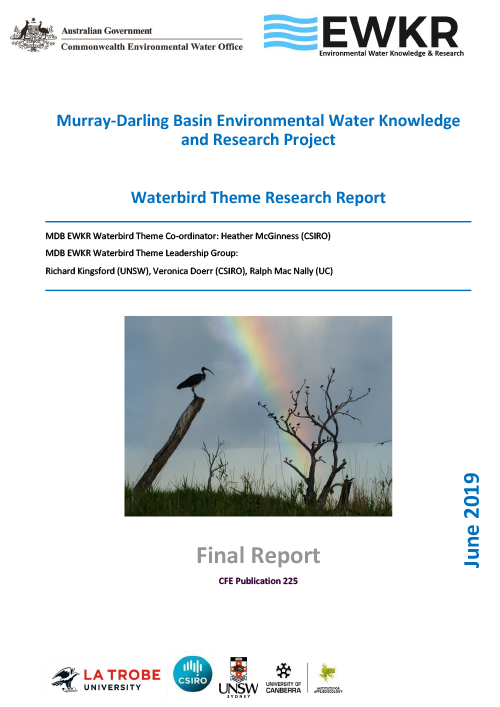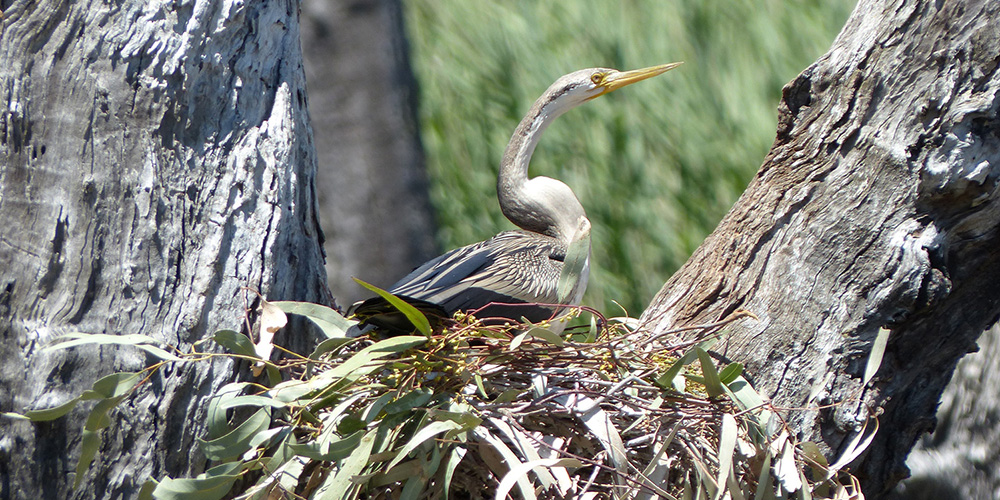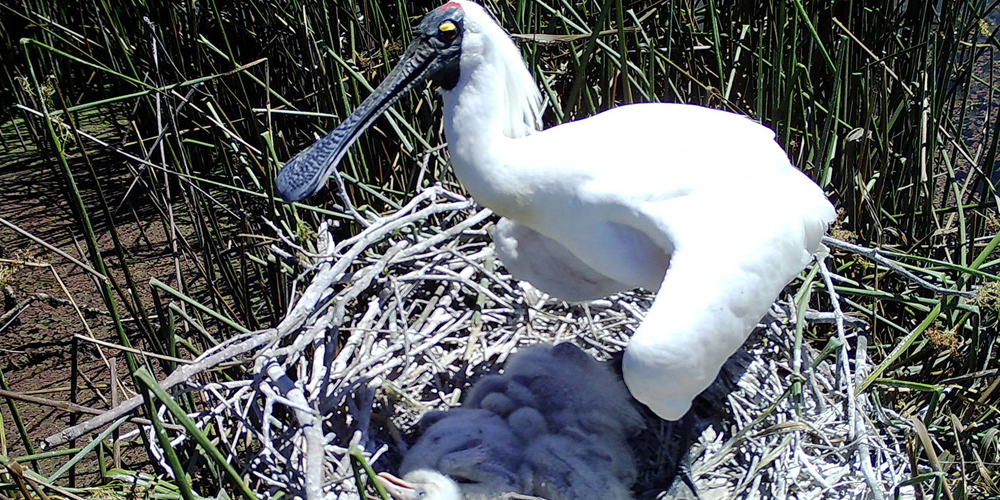
Theme Coordinator: Heather McGinness
River floodplain wetlands provide critical waterbird habitats, however the quality and availability of these sites are influenced by our water and vegetation management decisions. Protecting and maintaining suitable feeding and nesting habitats both between and during rain and flood events is essential to maximise waterbird recruitment, maintain populations, and conserve biodiversity. This requires careful management of both vegetation and water regimes at a range of scales.
The use of valuable ‘environmental water’ within Australia’s Murray-Darling Basin has often been focused on supporting completion of waterbird breeding events at nesting sites. However managers and policy-makers are becoming increasingly conscious of the need to also manage feeding sites and food sources at Basin scales. Appropriately managing environmental water placement is critical to facilitating the recruitment of juvenile birds into waterbird populations. Yet we lack basic knowledge of how water flows interact with other factors such as predation, weather extremes and food abundance to influence recruitment. For most species we also lack knowledge of the movements of adults and young during and between breeding events – where do they go, and why? Filling these knowledge gaps is key to improving the efficiency of environmental water management – applying water to the right places at the right times – and ensuring the success of future breeding events and waterbird recruitment.
The Waterbird Theme of the Murray-Darling Basin Environmental Water Knowledge and Research Project (MDB EWKR) began filling these knowledge gaps and aspects of this research are now being continued as part of the Commonwealth Environmental Water Office’s Basin-scale Monitoring, Evaluation and Research Project. By quantifying survival rates, movements, and their drivers using innovative modern technology such as GPS satellite tracking, this research is assisting managers to identify key waterbird habitats and gain a better understanding of the scales at which habitats and environmental flows are required to support waterbird populations.
Key outcomes:
For additional notes on each key outcome, please refer to the respective section numbers within the full report (provided further below).
The research conducted by the MDB EWKR Waterbird Theme has produced new information to assist managers to better target water, vegetation and waterbird management to ensure ‘event readiness’ at sites between flooding events and to maximise recruitment. Maximising recruitment into the adult population depends on optimising the number of birds that nest, the number of chicks that fledge from each site, and the survival of those birds as juveniles, sub-adults and breeding adults. Consequently, information is needed quantifying these variables and what affects them – however the mobility of waterbirds and lack of information on their movements makes this difficult. Therefore, the MDB EWKR Waterbird Theme research activities included: Detailed movement and habitat-use studies of individual birds over the duration of the EWKR project using tracking devices (satellite GPS transmitters); motion-sensing and time-lapse camera nest monitoring; on-ground tagged-nest and water depth monitoring; colony mapping; analysis of chick diet and energy sources; and modelling of chick energy requirements.
Satellite-tracking of waterbird movements has:
- Emphasised the need for Basin scale thinking and coordination in planning environmental water allocations and in managing expectations regarding waterbird responses. There is clearly population connectivity between the northern Basin and the southern Basin – and birds can move very quickly from north to south and vice versa (Section 2.2, 2.3).
- Discovered a common movement route between the northern and southern Basin, which suggests that for maximum impact, water and site management for foraging and stopover (refuelling) could be embedded within this route. Additional tracking of species dependent on surface water to feed will provide further information about key sites and movement routes that can be managed with environmental water (Section 2.2).
- Revealed distinct variation in movement behaviour between and within species, with varying degrees of resident, nomadic and migratory behaviour. Planning and response predictions may need to account for varying population movement strategies and for differences between species (Section 2.2, 2.3).
- Found that relatively few of the satellite-tracked birds moved to the east coast or to central Australia after nesting. The majority stayed within the Murray-Darling Basin, emphasising the importance of the Basin for these populations (Section 2.2, 2.3).
- Suggested that foraging habitat availability needs management both during and between breeding events. For example, satellite tracking suggests that ibis and spoonbills target watered foraging sites within 1-3 km of appropriate roosting or nesting habitat. Environmental water could be used to increase the number or area of foraging sites available after breeding, potentially extending watering for foraging into autumn and winter and possibly staggering inundation of foraging sites to maximise food productivity over a period of months to support juvenile survival (Section 2.2, 2.3).
- Revealed the importance of extended duration of water availability for foraging by juvenile royal spoonbills. Use of environmental water to extend nest and adjacent site flood duration during and after nesting beyond just the ‘fledging’ time threshold may facilitate increased juvenile survival (Section 2.2).
- Suggested that management of over-wintering sites and foraging habitats may also be important for juvenile survival. Overwintering occurs in both the north and south of MDB, yielding a range of opportunities for using environmental water to create or sustain foraging habitats and food sources. This may be particularly important in areas where irrigated agriculture and other water sources effectively ‘dry up’ over winter (Section 2.2).
- Emphasised that it is important to recognise that species such as spoonbills feeding in surface waters require different foraging-habitat provision and management to species with mixed terrestrial and aquatic diets such as ibis (Section 2.2, 2.8, 2.9, 2.10).
Remote motion-sensing and time-lapse cameras in nesting colonies have:
- Identified the primary predators of eggs and chicks in Barmah-Millewa Forest, with detailed photographs
- Proven predation of ibis eggs by pigs in Barmah-Millewa Forest, with detailed photographs
- Produced the first ever field-guide to visually ageing ibis and spoonbill chicks in Australia
- Allowed quantification of egg and chick survival and behaviour from hatching to nest site departure
- Documented detailed behaviour of adults and chicks and produced stunning photographs of these behaviours
- Documented the presence and produced quality photographs of a range of other species in monitored wetlands, including endangered Australasian Bitterns (these images have since been used by a range of stakeholders)
- Shown that nest abandonment is more likely during the egg stage than the chick stage, however it is still important to maintain water levels late in the breeding season, for two reasons: 1) Maintaining food and foraging habitat availability; and 2) Preventing feral predator access. In addition to provision of environmental water for breeding sites, provision of water to support nearby foraging sites and food before, during and after a breeding event is likely to affect the size and success of the event (Section 2.4, 2.5). With ongoing declines in waterbird populations, it is important that we understand how many birds are being produced by breeding events, together with what is affecting those numbers (Section 2.4, 2.5).
Measurement and modelling of chick diet and energy needs has found that:
- There is a paucity of data available describing the growth and energy requirements of ibis and spoonbill species (Threskiornithidae). This study has begun filling some of these knowledge gaps, through the extraction and synthesis of the best available data globally on Threskiornithid energetics, growth, and biometrics, and by creating the first growth model for Royal Spoonbill chicks and developing the first predictive energetic models of Australian waterbird chick energy requirements (Section 2.10)
Overall, increased knowledge of the interaction of waterbirds with their environment, their movements and their life histories is important for both basic understanding of their responses but also for informing policy and management decisions and predictions aimed at increasing waterbird abundance and maintaining waterbird diversity across the Basin (Section 3).
To download the full report, click the button below.





